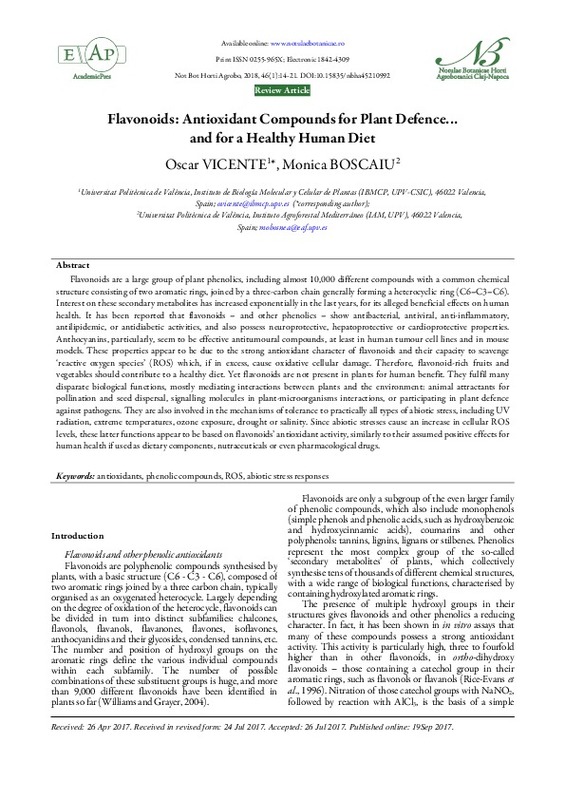JavaScript is disabled for your browser. Some features of this site may not work without it.
Buscar en RiuNet
Listar
Mi cuenta
Estadísticas
Ayuda RiuNet
Admin. UPV
Flavonoids: Antioxidant Compounds for Plant Defence... and for a Healthy Human Diet
Mostrar el registro sencillo del ítem
Ficheros en el ítem
| dc.contributor.author | Vicente, Oscar
|
es_ES |
| dc.contributor.author | Boscaiu, Monica
|
es_ES |
| dc.date.accessioned | 2019-06-07T20:02:26Z | |
| dc.date.available | 2019-06-07T20:02:26Z | |
| dc.date.issued | 2018 | es_ES |
| dc.identifier.issn | 0255-965X | es_ES |
| dc.identifier.uri | http://hdl.handle.net/10251/121736 | |
| dc.description.abstract | [EN] Flavonoids are a large group of plant phenolics, including almost 10,000 different compounds with a common chemical structure consisting of two aromatic rings, joined by a three-carbon chain generally forming a heterocyclic ring (C6-C3-C6). Interest on these secondary metabolites has increased exponentially in the last years, for its alleged beneficial effects on human health. It has been reported that flavonoids - and other phenolics - show antibacterial, antiviral, anti-inflammatory, antilipidemic, or antidiabetic activities, and also possess neuroprotective, hepatoprotective or cardioprotective properties. Anthocyanins, particularly, seem to be effective antitumoural compounds, at least in human tumour cell lines and in mouse models. These properties appear to be due to the strong antioxidant character of flavonoids and their capacity to scavenge 'reactive oxygen species' (ROS) which, if in excess, cause oxidative cellular damage. Therefore, flavonoid-rich fruits and vegetables should contribute to a healthy diet. Yet flavonoids are not present in plants for human benefit. They fulfil many disparate biological functions, mostly mediating interactions between plants and the environment: animal attractants for pollination and seed dispersal, signalling molecules in plant-microorganisms interactions, or participating in plant defence against pathogens. They are also involved in the mechanisms of tolerance to practically all types of abiotic stress, including UV radiation, extreme temperatures, ozone exposure, drought or salinity. Since abiotic stresses cause an increase in cellular ROS levels, these latter functions appear to be based on flavonoids' antioxidant activity, similarly to their assumed positive effects for human health if used as dietary components, nutraceuticals or even pharmacological drugs. | es_ES |
| dc.language | Inglés | es_ES |
| dc.publisher | AcademicPres (EAP) Publishing House | es_ES |
| dc.relation.ispartof | Notulae Botanicae Horti Agrobotanici Cluj-Napoca | es_ES |
| dc.rights | Reconocimiento (by) | es_ES |
| dc.subject | Antioxidants | es_ES |
| dc.subject | Phenolic compounds | es_ES |
| dc.subject | ROS | es_ES |
| dc.subject | Abiotic stress responses | es_ES |
| dc.subject.classification | BIOQUIMICA Y BIOLOGIA MOLECULAR | es_ES |
| dc.subject.classification | BOTANICA | es_ES |
| dc.title | Flavonoids: Antioxidant Compounds for Plant Defence... and for a Healthy Human Diet | es_ES |
| dc.type | Artículo | es_ES |
| dc.identifier.doi | 10.15835/nbha45210992 | es_ES |
| dc.rights.accessRights | Abierto | es_ES |
| dc.contributor.affiliation | Universitat Politècnica de València. Departamento de Ecosistemas Agroforestales - Departament d'Ecosistemes Agroforestals | es_ES |
| dc.contributor.affiliation | Universitat Politècnica de València. Departamento de Biotecnología - Departament de Biotecnologia | es_ES |
| dc.description.bibliographicCitation | Vicente, O.; Boscaiu, M. (2018). Flavonoids: Antioxidant Compounds for Plant Defence... and for a Healthy Human Diet. Notulae Botanicae Horti Agrobotanici Cluj-Napoca. 46(1):14-21. https://doi.org/10.15835/nbha45210992 | es_ES |
| dc.description.accrualMethod | S | es_ES |
| dc.relation.publisherversion | http://doi.org/10.15835/nbha45210992 | es_ES |
| dc.description.upvformatpinicio | 14 | es_ES |
| dc.description.upvformatpfin | 21 | es_ES |
| dc.type.version | info:eu-repo/semantics/publishedVersion | es_ES |
| dc.description.volume | 46 | es_ES |
| dc.description.issue | 1 | es_ES |
| dc.relation.pasarela | S\347953 | es_ES |








